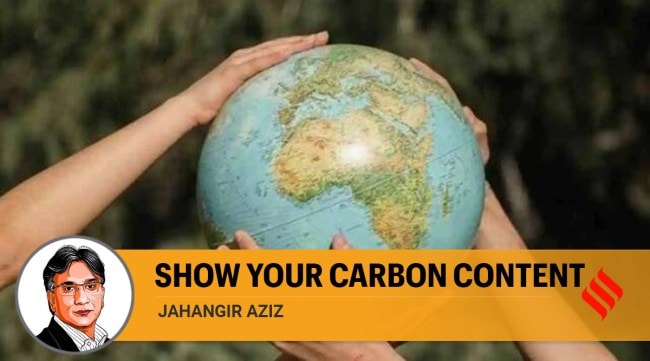Opinion Post-pandemic, climate change will drive investments
If the importing countries do not want to or cannot, because of regulations, use high-carbon products, then firms in emerging markets will either need to produce lower carbon products or pay the cost of offsetting the carbon-content differential. The time to worry is getting close
 After rising from 5.5 per cent of GDP in 2000-01 to nearly 14.5 per cent by 2007-08, corporate investment has flatlined around 10.5 per cent of GDP. Household investment rose to 15.7 per cent of GDP by 2011-12, declined to 9.4 per cent of GDP by 2015-16 and has recovered to just over 11.5 per cent of the GDP today (express photo)
After rising from 5.5 per cent of GDP in 2000-01 to nearly 14.5 per cent by 2007-08, corporate investment has flatlined around 10.5 per cent of GDP. Household investment rose to 15.7 per cent of GDP by 2011-12, declined to 9.4 per cent of GDP by 2015-16 and has recovered to just over 11.5 per cent of the GDP today (express photo) Three years after the pandemic and despite 8 per cent average growth over the last two years, the level of India’s GDP is still running 5 per cent below that implied by its pre-pandemic trajectory. This is a measure of the permanent scarring from the pandemic and unless India grows over 7-8 per cent in the coming years, the potential loss of GDP will only widen.
Many would argue that, as in the aftermath of the 2008 global financial crisis (GFC), the post-pandemic trend growth is likely to be lower, and thus, this is an artificially high benchmark. In the five years prior to the GFC, India averaged 8 per cent growth when rapid globalisation boosted exports and private investment soared to set up the needed supply chains. Since the GFC, global trade has languished and with it, so has investment.
After rising from 5.5 per cent of GDP in 2000-01 to nearly 14.5 per cent by 2007-08, corporate investment has flatlined around 10.5 per cent of GDP. Household investment rose to 15.7 per cent of GDP by 2011-12, declined to 9.4 per cent of GDP by 2015-16 and has recovered to just over 11.5 per cent of the GDP today. While some of this decline reflects the slowdown in residential housing, one suspects that a large part is due to falling SME investment, which is subsumed in this category.
Much has been said about the rise in central government public investment. While this is true, overall public sector investment has remained broadly unchanged at 7 per cent of GDP since the GFC, 1 percentage point lower than its peak before the crisis. The rise in central government capital spending has been offset by lower PSU investments, while state government investment has remained roughly unchanged. The public sector has neither compensated for the loss nor has it managed to “crowd-in” private investment.
The 4-5 per cent of GDP decline in overall investment since 2011-12 is mirrored in growth outcomes: GDP growth has averaged 6 per cent since the GFC and is slightly better at 6.7 per cent if the post-pandemic years are excluded. These outcomes are similar across other economies. In fact, within the emerging market (EM) world, India, along with other manufacturing exporters, has fared much better than commodity exporters.
The question is whether the pandemic will reset growth and investment lower as in the post-GFC years. The last two years’ average growth of 8 per cent is not a harbinger of how the medium term might pan out. It’s just a recovery from the around 6 per cent contraction in 2020. Growth in the two years after the pandemic averaged 8.2 per cent even though the economic damage from the GFC was far more benign than in the pandemic.
There are many reasons to believe that the world might see another leg down in economic activity, reflecting demographic shifts, falling productivity, high indebtedness, structural inflation, and interest rate among others. Then there are reasons not to.
The first relates to the relocation of global supply chains. Public discussions and debates on this often conflate two separate drivers of the relocation. One type of relocation is the “China + One” shift, where firms are locating part of their new supply chains outside China as an insurance against pandemic-type disruptions. In this type of relocation, economies such as India, Mexico, and Vietnam have and will benefit from more FDI and expansion of manufacturing exports. But size matters and these economies do not have the capacity to absorb more than a limited scale of relocation investments. For example, despite all the concerns around China, inward FDI totaled $524 billion over 2021-22, about $100 billion more than in the two years prior to the pandemic and accounted for 50 per cent of all FDI to EM manufacturing exporters. Over the same period, total FDI into India was $95 billion, about the same as in the two years before the pandemic. Thus, while the “China + One” relocation will be beneficial to some, it is unlikely to be as “game changing” as some commentators claim.
The second type of relocation goes by names such as re-shoring, near-shoring, or friend-shoring. This is based on security concerns of the West in locating supply chains related to emergent technologies, such as advanced semiconductors, AI and quantum computing in countries outside their “circle of trust,” which one presumes is shorthand for NATO and close allies. By this metric, even if EM economies had the needed ecosystem to establish the advanced supply chains, only a few (such as Korea, Mexico, and Poland) would belong in the circle-of-trust. It is very likely that the security-driven relocation will be firmly set within the developed world.
The other, and probably, bigger reason why investment might rise in the post-pandemic world is climate change. The world is moving irreversibly towards a lower carbon way of life. The investments required to achieve this will be massive. And the private sector will necessarily have to play a big role, not just in implementing public-funded projects (as it appears to be doing so now), but to compete.
There is a sense that because the COP26 commitments of EMs are several decades away, the private sector does not need to be overly concerned with these issues now. However, the binding constraint is not their own timeline, but those of the countries that buy EMs’ products, which are decades sooner. If the importing countries do not want to or cannot, because of regulations, use high-carbon products, then firms in EMs will either need to produce lower carbon products or pay the cost of offsetting the carbon-content differential. The costs of these offsets are still being worked out and remain uncertain. But the time to worry is getting close. As early as January 2026, Europe will be implementing its cross-border adjustment mechanism (CBAM) to offset the carbon differentials for six products including cement, iron and steel, and aluminium.
And that will just be the beginning. Over time, the list of goods will expand, services will be added, and more developed markets will adopt similar rules. Moreover, other EM economies, like China, are already well advanced in lowering the carbon content of their products. So those who start late, might well find themselves outcompeted not on cost but on lower-carbon content.
The writer is Chief Emerging Markets Economist, JP Morgan. Views are personal





